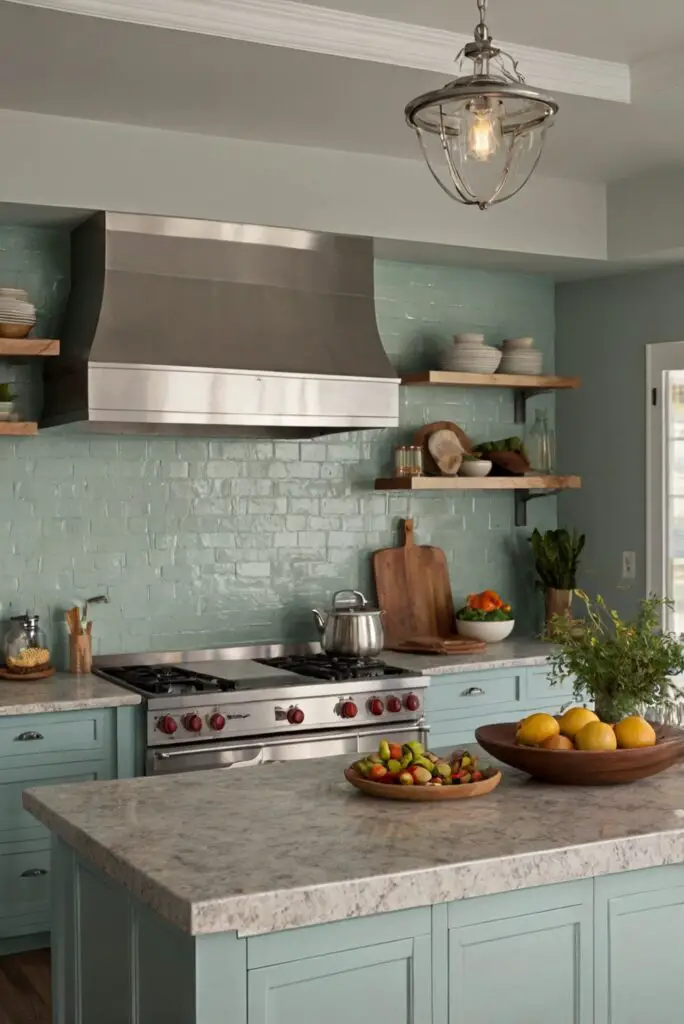Discover the expert tips and tricks for achieving the perfect balance of bold colors and neutral elements in your kitchen. Master the art of color coordination effortlessly.
To balance bold color choices with more neutral elements in your kitchen, start by choosing a bold color for a feature wall or cabinet and balancing it out with neutral tones for the rest of the space. Consider using vibrant hues for appliances or kitchenware to tie in the bold color choice. Make sure to select a color palette that complements each other, considering the color wheel for harmonious combinations. Utilize primer paint for walls to ensure a smooth finish when adding bold colors. Additionally, maintain a sense of organization in color placement and pair bold choices with neutral backsplashes or countertops for a cohesive look.
When incorporating bold colors into your kitchen design, it’s essential to strike a balance so that the space doesn’t feel overwhelming. Here are some strategies to help you achieve a harmonious blend of bold and neutral elements in your kitchen:
My Lovely Spring Paint for 2025
Ready for a Spring Makeover? Explore the Freshest 2025 Paint Trends!
White Sage/Green SW Pistachio green Soft blue Honeysweet/Orange Pink Sugar Sage Tint BMAs an Amazon Associate, I may earn a commission from qualifying purchases at no extra cost to you.
Sometimes less is more when it comes to bold colors in the kitchen. Focus on incorporating bold colors in smaller doses, such as with kitchen accessories, accent walls, or statement furniture pieces.
Introduce bold colors through kitchen textiles like curtains, rugs, or table linens. These elements can be easily changed or updated to refresh the color scheme without a major renovation.
Consider painting your kitchen cabinets in a bold color while keeping the walls neutral. This can create a visually striking focal point without overpowering the entire space.
My fAV Spring DECOR for 2025
Discover Spring’s Best 2025 Decor Combinations – Perfect for Any Room!
Oversized Indoor Plants White Curved Sofas Rugs BOH Brown Cream Moroccan Hype Boho Rug Outdoor Patio Furniture Sets Topfinel Pillow CoversAs an Amazon Associate, I may earn a commission from qualifying purchases at no extra cost to you.
Opt for neutral countertops, backsplashes, and flooring to balance out the bold colors in your kitchen. Neutral elements can provide a calming backdrop and allow the bold colors to stand out.
Incorporating natural materials like wood, stone, or metal can help soften the impact of bold colors and add depth and texture to your kitchen design.
Mixing multiple bold colors in your kitchen design can be done successfully by following the 60-30-10 rule. Choose one dominant color that covers 60% of the space, a secondary color for 30%, and an accent color for the remaining 10%.
When choosing a color palette for your kitchen that includes both bold and neutral elements, consider the overall mood and style you want to create. Bold colors can add energy and personality, while neutral tones provide balance and sophistication.
For a cohesive look with a mix of bold and neutral elements, create a color scheme that ties everything together. Consider using a color wheel to help you select complementary or analogous colors that work well together.
When selecting kitchen appliances, opt for finishes that complement both bold and neutral colors. Stainless steel appliances are versatile and can work well with a variety of color schemes. Black appliances can provide a sleek contrast against bold colors, while white appliances can blend seamlessly with neutral tones.
In conclusion, balancing bold color choices with more neutral elements in your kitchen requires thoughtful planning and careful consideration of the overall design. By incorporating bold colors in moderation, mixing colors strategically, and choosing complementary elements, you can create a kitchen that is visually appealing and harmonious.
**Key Takeaways:**
– Incorporate bold colors in smaller doses to avoid overwhelming the space.
– Use natural materials to soften the impact of bold colors and add texture.
– Follow the 60-30-10 rule when mixing multiple bold colors in your kitchen design.
– Choose a cohesive color scheme that ties together bold and neutral elements.
– Select kitchen appliances with finishes that complement both bold and neutral colors.







